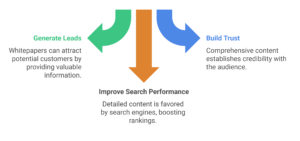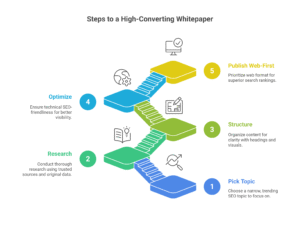SEO whitepapers are powerful digital marketing tools that can transform your brand from another voice in the crowd to a trusted authority. They serve as comprehensive resources that establish expertise while driving organic traffic and generating qualified leads.
However, most businesses create whitepapers incorrectly. They compile basic industry statistics and expect immediate results without understanding the strategic approach required for success.
This guide provides a complete roadmap for creating SEO whitepapers that rank on Google, generate real leads, and establish your authority in the search engine optimization space.
What Is an SEO Whitepaper?
An SEO whitepaper is a detailed, authoritative guide on a specific SEO topic that helps readers learn while boosting your brand’s authority in the search engine optimization space.
Unlike typical blog posts that cover surface-level information, SEO whitepapers provide comprehensive, data-driven insights. While a blog post might discuss “How to Do Keyword Research,” a whitepaper explores “Advanced Keyword Research Strategies for Enterprise SEO in 2024.”
The key difference lies in depth and authority. Quality whitepapers explain not just what to do, but why strategies work, supported by data and step-by-step implementation guides.
Why SEO Whitepapers Still Matter

They generate leads, build trust, and improve your website’s search performance when executed properly.
Despite shorter attention spans, long-form content remains valuable for several reasons:
Google prioritizes comprehensive content. Search engines favor resources that thoroughly answer user queries, which well-crafted whitepapers accomplish effectively.
Decision-makers consume detailed content. Business leaders and purchasing decision-makers prefer authoritative, comprehensive resources over brief social media posts.
They establish genuine credibility. Creating comprehensive, research-backed whitepapers requires expertise and significant effort, which builds trust with your target audience.
Who Should Use SEO Whitepapers?
SEO whitepapers work exceptionally well for specific professionals and businesses:
- Digital marketers seeking high-authority content – Establishing thought leadership in competitive digital marketing spaces
- SEO specialists building backlink profiles – Creating linkable assets that attract natural, high-quality backlinks
- Businesses explaining complex SEO concepts to clients – Providing detailed explanations beyond brief email communications
- SaaS companies in the marketing space – Demonstrating product knowledge and industry expertise
- Consultants and agencies – Showcasing capabilities to attract premium clients
Any business wanting to establish authority in their industry can benefit from SEO whitepapers, provided the topic aligns with audience needs and business objectives.
How to Write a High-Converting SEO Whitepaper

Creating effective whitepapers requires strategic planning, thorough research, and understanding your audience’s specific needs and pain points.
1. Pick a Laser-Focused Topic
Most whitepapers fail because they attempt to cover too much ground, resulting in unfocused content that serves no one effectively.
Instead, choose narrow, deep topics using these strategies:
- Target trending SEO topics: AI in SEO, Google algorithm updates, Core Web Vitals, E-E-A-T, voice search optimization
- Use Google Trends and Keyword Planner to validate demand – Let data guide your topic selection rather than assumptions
- Analyze competitor gaps – Identify topics your competitors haven’t covered comprehensively
- Monitor SEO communities – Reddit, Facebook groups, and forums reveal real questions from real users
For example, rather than “The Complete Guide to SEO,” focus on “How AI Tools Are Transforming Local SEO Strategies for Small Businesses in 2024.” The second topic targets a specific audience with a timely, actionable focus.
2. Research Like a Pro
Authoritative research separates professional whitepapers from amateur content that lacks credibility and actionable insights.
- Source data from trusted authorities: Google Search Central, Moz, Search Engine Journal, Ahrefs, SEMrush studies
- Include original case studies and examples – Show real results with before-and-after data, even if anonymized
- Conduct original surveys or interviews – Primary research adds unique value competitors cannot replicate
- Set up Google Alerts for your topic – Stay current with latest developments and incorporate fresh insights
Don’t simply collect statistics. Interpret data meaningfully, explaining what numbers mean and how readers can apply insights to their specific situations.
3. Structure It for Maximum Clarity
Even excellent information becomes worthless if presented confusingly. Your whitepaper must be scannable, logical, and digestible.
- Use short sections with descriptive headings – Break content into bite-sized chunks that support different reading patterns
- Add visual elements: charts, infographics, screenshots, diagrams – Visuals explain complex concepts and maintain engagement
- Include actionable elements: bullet points, checklists, callouts, templates – Make content immediately applicable
- Create a detailed table of contents – Help readers navigate and give search engines content structure signals
Consider how readers will actually use your whitepaper. They may not read linearly but instead jump to specific sections. Your structure should support this behavior with clear navigation and standalone section value.
4. Make It Technically SEO-Friendly
Outstanding content needs technical optimization to achieve maximum search visibility and user experience.
- Implement schema markup for articles or how-to content – Help search engines understand your content type and potentially earn rich snippets
- Ensure mobile optimization and fast loading times – More users read long-form content on mobile devices than desktop
- Add strategic internal links to related content – Connect to relevant blog posts, service pages, and resources naturally
- Optimize images with descriptive alt text – Improve accessibility while supporting image search visibility
- Use clean, descriptive URLs – Make URLs readable and keyword-relevant
Technical fundamentals matter significantly for long-form content. Ensure your whitepaper loads quickly, displays properly across devices, and provides excellent user experience.
5. Publish in Web-First Format
Many businesses limit their whitepaper’s potential by prioritizing PDF format over web-optimized pages.
- Publish as web pages for superior search rankings – Web pages offer better crawlability, faster loading, and social sharing capabilities than PDFs
- Offer PDF downloads for lead generation – Use PDFs as gated content to capture email addresses while keeping web versions accessible
- Create shareable web sections – Allow users to link to specific whitepaper sections for better social media sharing
- Enable easy navigation – Add jump links, back-to-top buttons, and clear section divisions
Consider a hybrid approach: publish complete content as an optimized web page, then offer a beautifully formatted PDF as a bonus for email subscribers.
Essential Topics to Cover in an SEO Whitepaper
Certain SEO topics consistently generate interest and deliver value to readers across skill levels:
- On-page SEO optimization: Meta tags, heading structure, image optimization, content optimization strategies
- Off-page SEO tactics: Link building strategies, digital PR campaigns, guest posting best practices
- Technical SEO fundamentals: Site crawlability, XML sitemaps, canonical tags, site architecture
- Google algorithm updates: Helpful Content Update, Core Updates, and adaptation strategies
- Mobile-first indexing and Core Web Vitals: Performance optimization and user experience factors
- Emerging SEO trends: Voice search optimization, AI-enhanced search behavior, visual search
- Advanced strategies: Content clustering, topical authority building, semantic SEO
- Local SEO tactics: Google Business Profile optimization, local citation building, review management
Choose one area for deep exploration rather than surface-level coverage of multiple topics. Your goal is becoming the definitive resource on that specific subject.
Advanced Tips to Make Your Whitepaper Stand Out
These advanced techniques elevate good whitepapers to exceptional resources that drive significant business results:
Add Real Results and Case Studies
Show before-and-after results with detailed graphs and traffic analysis.
Nothing builds credibility like documented results. Include specific metrics, timelines, and implementation details that readers can learn from and adapt.
Effective case study elements include:
- Baseline metrics and challenges faced
- Specific strategies implemented with timelines
- Measurable results with supporting screenshots
- Lessons learned and optimization recommendations
If you lack original case studies, analyze publicly available data from companies that have shared their SEO success stories, or partner with other professionals for mutual case study development.
Use Expert Quotes and Insights
Include quotes from recognized SEO experts to increase credibility and shareability.
Expert contributions serve multiple purposes: they add authority to your content, provide diverse perspectives, and often result in experts sharing your whitepaper with their audiences.
When reaching out to experts:
- Prepare specific, thoughtful questions tied to your whitepaper theme
- Ask for predictions or unique insights rather than generic advice
- Include their bio and link to their work as appreciation
- Follow up with the finished whitepaper for their review and sharing
Include Interactive Tools and Resources
Embed practical tools: SEO calculators, audit checklists, keyword difficulty analyzers.
Interactive elements transform passive reading into engaging, practical experiences that provide immediate value.
Consider creating:
- ROI calculators for SEO investment planning
- Technical SEO audit checklists with scoring systems
- Keyword research templates and worksheets
- Content gap analysis frameworks
- Link building outreach email templates
Promoting Your Whitepaper for SEO and Visibility
Creating exceptional content is only the first step. Strategic promotion ensures your whitepaper reaches the right audience and generates intended results.
- Segmented email campaigns – Target specific audience segments with tailored messaging that highlights relevant whitepaper sections
- Guest posting and influencer outreach – Write for industry publications and naturally reference your whitepaper as a comprehensive resource
- Social media promotion across platforms – Share on LinkedIn with professional insights, Twitter with key statistics, and relevant SEO communities with helpful excerpts
- UTM tracking for performance measurement – Monitor which promotion channels generate the most engagement and conversions
- Internal team enablement – Ensure sales teams understand the whitepaper’s value and can use it in prospect conversations
- Strategic partnerships – Collaborate with complementary businesses for cross-promotion opportunities
Create multiple content formats from your whitepaper: social media posts, LinkedIn articles, email newsletters, video summaries, and podcast discussions. Different audiences consume content through different channels and formats.
SEO Whitepaper Examples by Skill Level
Targeting different skill levels expands your audience reach and guides readers through their SEO learning journey.
Beginner Level
Beginner-focused whitepapers should assume no prior SEO knowledge and emphasize foundational concepts:
- Complete SEO Glossary: Comprehensive terminology guide with practical examples and visual explanations
- How Search Engines Work: Visual breakdown of crawling, indexing, and ranking processes with real-world analogies
- SEO Myths vs. Facts: Debunking common misconceptions with current best practices
- First 30 Days of SEO: Step-by-step beginner action plan with prioritized tasks
Intermediate Level
Intermediate content assumes basic SEO understanding and focuses on practical implementation and strategy refinement:
- Link Building Strategies That Work in 2024: Detailed tactics with email templates, outreach strategies, and success metrics
- Mastering SEO Tools: Comprehensive guides to Ahrefs, SEMrush, Screaming Frog with advanced feature usage
- Content Strategy for SEO: Topic research, content planning, and optimization frameworks
- Local SEO Implementation Guide: Complete local optimization with templates and checklists
Advanced Level
Advanced whitepapers tackle complex topics that challenge even experienced SEO professionals:
- Core Web Vitals Optimization: Technical deep-dives with code examples, performance tools, and optimization strategies
- Advanced Internal Linking Architecture: Strategic site structure planning and link equity distribution
- Enterprise SEO at Scale: Managing SEO for large websites with complex technical requirements
- AI and Machine Learning in SEO: Leveraging artificial intelligence for SEO strategy and implementation
Conclusion
An SEO whitepaper isn’t just content—it’s a trust-building, lead-generating asset that establishes lasting authority. Focus on delivering genuine value, maintaining technical accuracy, and creating user-friendly structure for optimal ranking and conversion results.
The difference between whitepapers that generate business results and those that get ignored lies in strategic execution. Success requires presenting valuable information in accessible, actionable formats that genuinely serve your audience’s needs.
Your whitepaper often represents the first substantial interaction potential clients have with your expertise. Demonstrate that you understand their challenges, possess practical solutions, and can communicate complex concepts clearly and helpfully.
The SEO landscape evolves constantly, but authoritative, comprehensive content remains valuable. By creating whitepapers that truly serve your audience, you build foundations for sustainable organic growth and long-term business success.
Choose a topic that matters to your target audience, research it thoroughly, and create something genuinely valuable. Your future clients and search rankings will reflect the quality of your effort and strategic approach.


